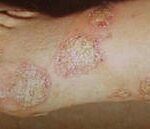Reactive arthritis occurs when there are infections occurring in other parts of the body that come to affect the joints. Infections that stimulate reactive arthritis include prostatitis (inflamed prostate), psoriasis (inflammation of the skin), Salmonella, Shigella, Pseudomonas, Campylobacter, or Ureaplasma urealyticum infections, and venereal diseases such as herpes, gonorrhea, Chlamydia, and others.
Septic arthritis or acute infectious arthritis is a form of reactive arthritis wherein bacteria or other microorganisms invade the joints. These can be the same microorganisms just mentioned or many others. Whether microorganisms actually invade the joint capsule or simply stimulate inflammatory cytokines is not always clear in every case. A rheumatic arthritic joint will often be permeable to septic infection by microorganisms. Septic infections are also often accompanied by other symptoms such as fever and digestive difficulties. Symptoms of this form of arthritis include sharp, immediate and piercing pain within a few joints or even a single joint. This can occur at any age. Infective arthritis can affect young children as well, who may be infected by H. influenzae or Streptococcus pneumoniae.
A subset of septic arthritis is disseminated gonococcal infection, or DGI. This is often caused by a gonorrhea infection – a sexually transmitted disease. This can also cause fever, chills, random limb motion, and dermatitis. The skin can break out in pustules, vesicles and lesions. This can occur in different places on the skin, and can occur near the joint pain.
Nongonococcal septic arthritis is infective arthritis caused by bacteria other than gonorrhea. This form is actually a further descriptor for the same septic arthritis discussed above.
Lyme disease is another form of septic or reactive arthritis. Here the lyme bacterium, Borrelia burgdorferi in the U.S. and Borrelia afzelii in Europe, infect the body and sometimes the synovial fluid and cartilage. Lyme is officially thought to be caused by an infected tick bite, although other routes of infection have been identified in recent years. The bacterium has been shown to burrow and incubate into certain tissues, where it can emerge when the immune system is in a weakened state.
Infective sources vary greatly to the infection. This can range from skin contact, food, water, household or work environment contamination to many others. Microorganisms such as Pseudomonas sp., for example, can penetrate the skin to infect joints simply from handling an object infected with the bacteria.
Treatment for reactive septic arthritis depends upon the infection and the mode of entry. An important part of the strategy is to make sure the infective source is abandoned. Often the body’s immune system can fight off a minor infection once the infective source is discontinued; depending upon the infective agent and the strength of the immune system. A health professional should be consulted immediately, especially if the infection continues after removing the infective source. Septic arthritis can be serious and can worsen quickly, so a physician’s care is suggested.



